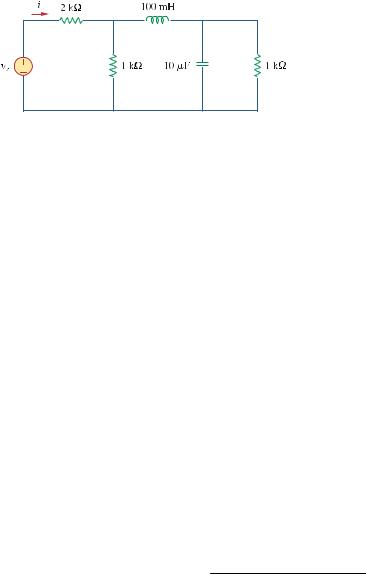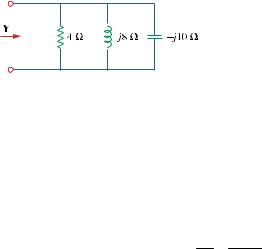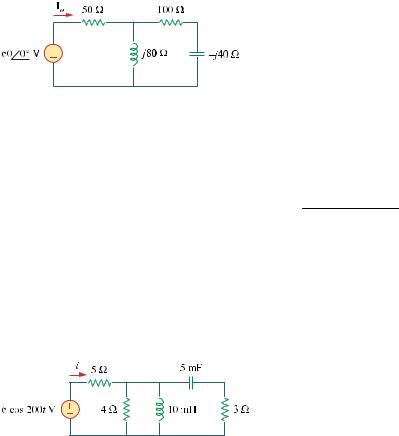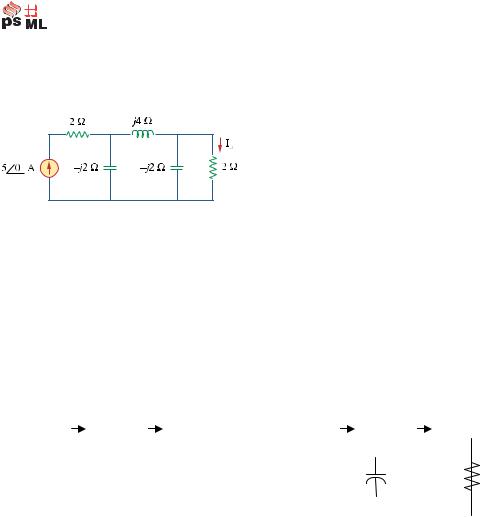
Chapter09
.pdf
Chapter 9, Problem 36.
In the circuit of Fig. 9.43, determine i. Let v s = 60 cos(200t - 10 o )V.
Figure 9.43
For Prob. 9.36.
Chapter 9, Solution 36.
Let Z be the input impedance at the source.
100 mH |
→ |
jωL = j200x100x10−3 = j20 |
||||
10µF |
→ |
1 |
= |
1 |
= − j500 |
|
jωC |
j10x10−6 x200 |
|||||
|
|
|
|
|||
1000//-j500 = 200 –j400
1000//(j20 + 200 –j400) = 242.62 –j239.84
Z = 2242.62 − j239.84 = 2255 −6.104o
I = |
60 −10o |
= 26.61 −3.896o mA |
|
2255 −6.104o |
|||
|
|
i = 266.1cos(200t −3.896o ) mA
PROPRIETARY MATERIAL. © 2007 The McGraw-Hill Companies, Inc. All rights reserved. No part of this Manual may be displayed, reproduced or distributed in any form or by any means, without the prior written permission of the publisher, or used beyond the limited distribution to teachers and educators permitted by McGraw-Hill for their individual course preparation. If you are a student using this Manual, you are using it without permission.

Chapter 9, Problem 37.
Determine the admittance Y for the circuit in Fig. 9.44.
Figure 9.44
For Prob. 9.37.
Chapter 9, Solution 37.
Y = 14 + j18 + −1j10 = 0.25 − j0.025 S = 250–j25 mS
PROPRIETARY MATERIAL. © 2007 The McGraw-Hill Companies, Inc. All rights reserved. No part of this Manual may be displayed, reproduced or distributed in any form or by any means, without the prior written permission of the publisher, or used beyond the limited distribution to teachers and educators permitted by McGraw-Hill for their individual course preparation. If you are a student using this Manual, you are using it without permission.

Chapter 9, Problem 38.
Find i(t) and v(t) in each of the circuits of Fig. 9.45.
Figure 9.45
For Prob. 9.38.
Chapter 9, Solution 38. |
|
|
|
|
|||
|
1 |
|
|
1 |
1 |
|
|
(a) |
|
F |
→ |
|
= |
|
= -j2 |
6 |
jωC |
j(3)(1/ 6) |
|||||
- j2
I = 4 − j2 (10 45°) = 4.472 -18.43° Hence, i(t) = 4.472 cos(3t – 18.43°) A
V = 4I = (4)(4.472 -18.43°) =17.89 -18.43°
Hence, v(t) = 17.89 cos(3t – 18.43°) V
|
1 |
|
|
|
|
|
1 |
1 |
|
|
||||
(b) |
|
|
|
F |
→ |
|
|
|
= |
|
|
= -j3 |
||
12 |
|
|
jωC |
j(4)(1/12) |
||||||||||
|
3 H |
→ |
jωL = j(4)(3) = j12 |
|
||||||||||
|
I = |
|
V |
|
50 0° |
|
|
|
|
|||||
|
|
|
= |
|
=10 36.87° |
|
||||||||
|
|
Z |
4 − j3 |
|
||||||||||
Hence, i(t) = 10 cos(4t + 36.87°) A
j12
V = 8 + j12 (50 0°) = 41.6 33.69°
Hence, v(t) = 41.6 cos(4t + 33.69°) V
PROPRIETARY MATERIAL. © 2007 The McGraw-Hill Companies, Inc. All rights reserved. No part of this Manual may be displayed, reproduced or distributed in any form or by any means, without the prior written permission of the publisher, or used beyond the limited distribution to teachers and educators permitted by McGraw-Hill for their individual course preparation. If you are a student using this Manual, you are using it without permission.

Chapter 9, Problem 39.
For the circuit shown in Fig. 9.46, find Z eg and use that to find current I. Let ω = 10 rad/s.
Figure 9.46
For Prob. 9.39.
Chapter 9, Solution 39.
Zeq = 4 + j20 +10 //(− j14 + j25) = 9.135 + j27.47 Ω
I = |
V |
= |
12 |
= 0.4145 < −71.605o |
|
9.135 + j27.47 |
|||
|
Zeq |
|
||
i(t) = 0.4145cos(10t −71.605o ) A = 414.5cos(10t–71.6˚) mA
PROPRIETARY MATERIAL. © 2007 The McGraw-Hill Companies, Inc. All rights reserved. No part of this Manual may be displayed, reproduced or distributed in any form or by any means, without the prior written permission of the publisher, or used beyond the limited distribution to teachers and educators permitted by McGraw-Hill for their individual course preparation. If you are a student using this Manual, you are using it without permission.

Chapter 9, Problem 40.
In the circuit of Fig. 9.47, find i o when:
(a) ω = 1 rad/s |
|
|
|
|
(b) ω = 5 rad/s |
|||||
(c) ω = 10 rad/s |
|
|
|
|
|
|||||
|
|
|
|
|
|
|
|
|
|
|
|
|
|
|
|
|
|
|
|
|
|
|
|
|
|
|
|
|
|
|
|
|
|
|
|
|
|
|
|
|
|
|
|
|
|
|
|
|
|
|
|
|
|
|
|
|
|
|
|
|
|
|
|
|
|
|
|
|
|
|
|
|
|
|
|
|
Figure 9.47
For Prob. 9.40.
PROPRIETARY MATERIAL. © 2007 The McGraw-Hill Companies, Inc. All rights reserved. No part of this Manual may be displayed, reproduced or distributed in any form or by any means, without the prior written permission of the publisher, or used beyond the limited distribution to teachers and educators permitted by McGraw-Hill for their individual course preparation. If you are a student using this Manual, you are using it without permission.
Chapter 9, Solution 40.
(a)For ω=1,
1 H |
→ |
jωL = j(1)(1) = j |
|
|
|
|
|||||||||||
0.05 F |
→ |
1 |
= |
|
1 |
|
|
= -j20 |
|
||||||||
jωC |
j(1)(0.05) |
|
|||||||||||||||
Z = j + 2 || (-j20) = j + |
|
- j40 |
=1.98 + j0.802 |
||||||||||||||
2 − j20 |
|
||||||||||||||||
Io = |
V |
= |
|
|
4 0° |
= |
|
|
4 0° |
|
=1.872 - 22.05° |
||||||
Z |
1.98 + j0.802 |
2.136 22.05° |
|||||||||||||||
|
|
|
|
|
|||||||||||||
Hence, io (t) = 1.872 cos(t – 22.05°) A
(b)For ω= 5 ,
1 H |
→ jωL = j(5)(1) = j5 |
|
|||||||||||
|
|
|
|
1 |
1 |
|
|
|
|||||
0.05 F |
→ |
|
|
= |
|
|
|
|
|
= -j4 |
|||
jωC |
j(5)(0.05) |
||||||||||||
Z = j5 + 2 || (-j4) = j5 + |
|
- j4 |
|
||||||||||
|
=1.6 |
+ j4.2 |
|||||||||||
1− j2 |
|||||||||||||
Io = |
V |
= |
4 0° |
|
= |
|
|
|
4 0° |
|
= 0.89 - 69.14° |
||
Z |
|
|
4.494 69.14° |
||||||||||
|
1.6 + j4 |
|
|||||||||||
Hence, io (t) = 0.89 cos(5t – 69.14°) A
(c)For ω=10 ,
1 H |
→ jωL = j(10)(1) = j10 |
|
||||||||||||||
|
|
|
|
|
|
|
1 |
1 |
|
|
|
|
|
|||
0.05 F |
→ |
|
|
|
= |
|
|
|
|
= -j2 |
||||||
|
jωC |
j(10)(0.05) |
||||||||||||||
Z = j10 + 2 || (-j2) = j10 + |
- j4 |
=1 |
+ j9 |
|||||||||||||
2 − j2 |
||||||||||||||||
Io = |
V |
= |
4 0° |
|
= |
|
|
4 0° |
|
|
= 0.4417 - 83.66° |
|||||
Z |
1+ j9 |
|
9.055 83.66° |
|||||||||||||
|
|
|
|
|
|
|
|
|||||||||
Hence, io (t) = 0.4417 cos(10t – 83.66°) A
PROPRIETARY MATERIAL. © 2007 The McGraw-Hill Companies, Inc. All rights reserved. No part of this Manual may be displayed, reproduced or distributed in any form or by any means, without the prior written permission of the publisher, or used beyond the limited distribution to teachers and educators permitted by McGraw-Hill for their individual course preparation. If you are a student using this Manual, you are using it without permission.

Chapter 9, Problem 41.
Find v(t) in the RLC circuit of Fig. 9.48.
Figure 9.48
For Prob. 9.41.
Chapter 9, Solution 41. |
|
|
|
|
|
|
|
|
|
|
|||||
|
ω=1, |
|
|
|
|
|
|
|
|
|
|
||||
1 H |
|
→ |
jωL = j(1)(1) = j |
|
|||||||||||
|
|
|
|
|
|
|
|
1 |
1 |
|
|
|
|
|
|
1 F |
|
→ |
|
|
= |
|
|
= -j |
|
||||||
jωC |
j(1)(1) |
|
|||||||||||||
Z =1+ |
(1+ j) || (-j) =1+ |
- j +1 |
= 2 − j |
|
|||||||||||
1 |
|
||||||||||||||
I = |
|
Vs |
|
= |
10 |
|
|
, |
Ic = (1+ j) I |
|
|||||
|
Z |
2 − j |
|
||||||||||||
|
|
|
|
|
|
|
|
|
|
|
|||||
V = (-j)(1+ j) I = (1− j) I = |
|
(1− j)(10) |
= 6.325 -18.43° |
||||||||||||
|
|
2 − j |
|||||||||||||
Thus, |
v(t) |
= 6.325 cos(t – 18.43°) V |
|
||||||||||||
PROPRIETARY MATERIAL. © 2007 The McGraw-Hill Companies, Inc. All rights reserved. No part of this Manual may be displayed, reproduced or distributed in any form or by any means, without the prior written permission of the publisher, or used beyond the limited distribution to teachers and educators permitted by McGraw-Hill for their individual course preparation. If you are a student using this Manual, you are using it without permission.

Chapter 9, Problem 42.
Calculate v o (t) in the circuit of Fig. 9.49.
Figure 9.49
For Prob. 9.42.
Chapter 9, Solution 42.
|
ω= 200 |
1 |
1 |
|
|
|
|
|
|||
50 µF |
→ |
|
= |
|
= -j100 |
jωC |
j(200)(50 ×10-6 ) |
||||
0.1 H |
→ |
jωL = j(200)(0.1) = j20 |
|
||
|
|
|
(50)(-j100) - j100 |
|
|
|
|||
|
50 || -j100 = |
|
= |
|
= 40 − j20 |
||||
|
50 − j100 |
1- j2 |
|||||||
|
V = |
|
j20 |
|
(60 0°) = |
j20 |
(60 0°) =17.14 90° |
||
|
|
|
|
|
|||||
|
o |
j20 +30 + 40 − j20 |
|
|
70 |
|
|||
|
|
|
|
|
|||||
Thus, |
vo (t) = 17.14 sin(200t + 90°) V |
|
|
|
|||||
or |
|
vo (t) = 17.14 cos(200t) V |
|||||||
PROPRIETARY MATERIAL. © 2007 The McGraw-Hill Companies, Inc. All rights reserved. No part of this Manual may be displayed, reproduced or distributed in any form or by any means, without the prior written permission of the publisher, or used beyond the limited distribution to teachers and educators permitted by McGraw-Hill for their individual course preparation. If you are a student using this Manual, you are using it without permission.

Chapter 9, Problem 43.
Find current I o in the circuit shown in Fig. 9.50.
Figure 9.50
For Prob. 9.43.
Chapter 9, Solution 43.
Zin =50 + j80 //(100 − j40) =50 + j80(100 − j40) =105.71+ j57.93 100 + j40
Io = 60 < 0o = 0.4377 −0.2411 = 0.4997 < −28.85o A = 499.7 –28.85˚ mA
Zin
Chapter 9, Problem 44.
Calculate i(t) in the circuit of Fig. 9.51.
Figure 9.51
For prob. 9.44.
Chapter 9, Solution 44.
|
|
|
|
ω= 200 |
|
|
|
|
|
|
|||||||||
10 mH |
|
→ jωL = j(200)(10 ×10-3 ) = j2 |
|||||||||||||||||
|
|
|
|
|
|
|
|
|
|
1 |
|
1 |
|
|
|
||||
5 mF |
→ |
|
|
|
|
= |
|
|
|
|
= -j |
||||||||
|
jωC |
j(200)(5 ×10-3 ) |
|||||||||||||||||
Y = |
1 |
|
1 |
|
|
1 |
|
|
|
|
|
3 + j |
|
||||||
|
|
|
+ |
|
|
|
+ |
|
= |
0.25 − j0.5 + |
|
|
= 0.55 − j0.4 |
||||||
4 |
|
j2 |
3 − j |
10 |
|||||||||||||||
Z = |
1 |
= |
|
|
|
|
1 |
|
|
|
=1.1892 + j0.865 |
|
|||||||
|
Y |
|
0.55 − j0.4 |
|
|||||||||||||||
I = |
6 0° |
|
6 0° |
|
|||||||||||||||
|
= |
|
= 0.96 - 7.956° |
||||||||||||||||
5 + Z |
6.1892 + j0.865 |
||||||||||||||||||
Thus, i(t) = 0.96 cos(200t – 7.956°) A
PROPRIETARY MATERIAL. © 2007 The McGraw-Hill Companies, Inc. All rights reserved. No part of this Manual may be displayed, reproduced or distributed in any form or by any means, without the prior written permission of the publisher, or used beyond the limited distribution to teachers and educators permitted by McGraw-Hill for their individual course preparation. If you are a student using this Manual, you are using it without permission.

Chapter 9, Problem 45.
Find current I o in the network of Fig. 9.52.
Figure 9.52
For Prob. 9.45.
Chapter 9, Solution 45.
We obtain Io by applying the principle of current division twice.
I |
|
|
|
|
I2 |
|
|
|
|
|
|
|
|
|
|
|
|
|
|
|
|
|
|
I2 |
|
|
|
|
|
Io |
|
|
|
|
||
|
|
|
|
Z1 |
|
|
|
|
|
|
|
Z2 |
|
|
|
|
|
|
|
|
|
|
|
|
|
|
|
|
-j2 Ω |
|
|
|
2 Ω |
|||
|
|
|
|
|
|
|
|
|
|
|
|
|
|
|
|
|
|
|
|
|
|
|
|
|
|
|
|
|
|
|||||||
|
|
|
|
|
|
|
|
|
|
|
|
|
|
|
|
|
|
|
|
|
|
|
|
|
|
|
|
|
|
|||||||
|
|
|
|
|
|
|
|
|
|
|
|
|
|
|
|
|
|
|
|
|
|
|
|
|
|
|
||||||||||
|
|
|
|
|
|
|
|
|
|
|
|
|
|
|
|
|
|
|
|
|
|
|
|
|
|
|
|
|
|
|
|
|
|
|
|
|
|
|
|
|
|
|
|
|
|
|
|
|
|
|
|
|
|
|
|
|
|
|
|
|
|
|
|
|
|
|
|
|
|
|
|
|
|
|
|
|
|
|
|
|
|
|
|
|
|
|
|
|
|
|
|
|
|
|
|
|
|
|
|
|
|
|
|
|
|
|
|
|
|
|
|
|
|
|
|
|
|
|
|
|
|
|
|
|
|
|
|
|
|
|
|
|
|
|
|
|
|
|
|
|
|
|
|
|
|
|
|
|
|
|
(a) |
|
|
|
|
|
|
|
|
|
|
|
|
|
|
|
|
|
|
|
|
|
|
|
|
|
(b) |
|
|
|
|
|||
|
Z1 = -j2 , |
|
|
|
|
|
|
|
|
Z2 = j4 + |
(-j2) || 2 = j4 + |
- j4 |
=1+ j3 |
|||||||||||||||||||||||
|
|
|
|
|
|
|
|
2 - j2 |
||||||||||||||||||||||||||||
|
|
|
|
|
|
|
|
|
|
|
|
|
|
|
|
|
|
|
|
|
|
|
|
|
|
|
|
|
|
|
|
|
|
|
|
|
|
I2 |
= |
|
|
Z1 |
|
|
I = |
|
- j2 |
|
(5 0°) = |
|
- j10 |
|
|
|
|
|
|
||||||||||||||||
|
|
Z1 |
+ Z2 |
- j2 +1+ j3 |
1 |
+ j |
|
|
|
|
|
|||||||||||||||||||||||||
|
|
|
|
|
|
|
|
|
|
|
|
|
|
|
|
|
|
|
|
|
||||||||||||||||
|
|
|
|
|
- j2 |
|
|
|
|
- j |
- j10 |
|
-10 |
|
|
|
|
|
|
|
|
|
|
|
|
|
|
|||||||||
|
I |
o |
= |
|
|
|
I |
2 |
= |
|
|
|
|
|
= |
|
|
|
|
|
= –5 A |
|
|
|
|
|
||||||||||
|
2 - j2 |
|
|
|
1 |
+ |
1 |
|
|
|
|
|
||||||||||||||||||||||||
|
|
|
|
|
|
1- j |
1+ j |
|
|
|
|
|
|
|
|
|
|
|
|
|
|
|||||||||||||||
PROPRIETARY MATERIAL. © 2007 The McGraw-Hill Companies, Inc. All rights reserved. No part of this Manual may be displayed, reproduced or distributed in any form or by any means, without the prior written permission of the publisher, or used beyond the limited distribution to teachers and educators permitted by McGraw-Hill for their individual course preparation. If you are a student using this Manual, you are using it without permission.
